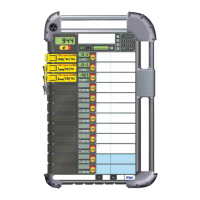In Use
Dräger PSS
®
Merlin
®
13
5In Use
An Entry Control Officer (ECO) is a competent person nominated to control and monitor an Entry Control Board (ECB) and to
direct and instruct all wearers of breathing apparatus (BA) at an incident.
A safe and secure entry control point (ECP) for the ECB should be established from which the ECO is able to effectively control
the adopted procedures. At this point the ECB can be mounted to a tripod to provide positive support and ease of use at an
incident.
The operational control procedures adopted should be in line with the requirements defined by the user or by national legislation
in the country of use. In the case of professional users, e.g. Fire Brigades, these guidelines are in addition to their own guidelines
for command and control procedures.
The following instructions cover the basic operational procedures and the in-use functional features of the Dräger PSS
®
Merlin
®
Telemetry System.
5.1 Pre-entry Procedure
Put on the breathing apparatus and carry out all functional checks as described in the Instructions for Use for the apparatus.
Activate the electronic monitoring system to operational mode. The red LED on IR Link Unit flashes (Bodyguard
®
II only).
5.2 Making Contact
5.2.1 Making Contact – Automatic
With the electronic monitoring system activated in operational mode, the wearer of the breathing apparatus passes the
encoded tally to the ECO with the following information written on the tally using a suitable waterproof marker:
The name of the wearer.
The cylinder contents pressure – shown on the electronic monitoring system.
If necessary, the ECO can check that the identification number on the label of the tally corresponds with the number on the
label of the electronic monitoring system. The ECO then writes the following information on the tally using a suitable
waterproof marker:
The actual time-in to the risk area (using the ECB clock).
Where a possibility of a radiation risk may be present, a prior-to-entry dosimeter reading.
The ECO fully inserts the tally into an available channel slot. The following rapid automatic activation and transmission
sequence starts:
1. The ECB immediately wakes up. A double sharp beep sounds (only as the first tally is installed).
2. A sensor in the selected channel reads and verifies the identification number in the transponder of the tally.
3. The radio in the ECB transmits a signal to the electronic monitoring system requesting to logon the unit to the ECB.
4. The radio of the electronic monitoring system transmits an acknowledgement signal to the ECB.
5. The ECB receives the logon acknowledgement – the data exchange starts.
6. The TTW value transmitted from the electronic monitoring system is added to the actual time shown on the real time clock to
determine the Time of Whistle (TOW).
7. The ECB starts the time elapsed count (minutes).
NOTICE
When the electronic monitoring system is activated to operational mode, it enters a standby mode, waiting for a signal
from the Entry Control Board (logon request).
NOTICE
If the ECB default setting is Time to Whistle (TTW), the ECO should observe the TTW reading on the electronic monitoring
system and add this time to the time-in, to establish an estimated Time of Whistle (TOW). Record the estimated TOW on the
remarks panel of the relevant channel.

